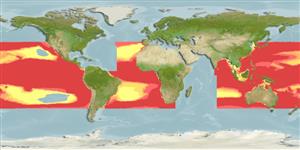Lớp phụ Cá sụn (cá mập và cá đuối) (sharks and rays) >
Lamniformes (Mackerel sharks) >
Megachasmidae (Megamouth sharks)
Etymology: Megachasma: megas (Gr.), large; chasma (Gr.), yawning hole or open mouth, referring to its unusually large oral cavity. (See ETYFish); pelagios: Greek for “of the sea,” referring to its oceanic, epipelagic habitat. (See ETYFish).
Environment: milieu / climate zone / depth range / distribution range
Sinh thái học
Biển; Ở đại duơng, biển (Ref. 51243); Mức độ sâu 5 - 600 m (Ref. 58302), usually 120 - 166 m (Ref. 48844). Deep-water; 40°N - 40°S, 180°W - 180°E
Pacific Ocean: Japan, Indonesia, Philippines, Hawaii and California, USA. Atlantic Ocean: Brazil and Senegal.
Length at first maturity / Bộ gần gũi / Khối lượng (Trọng lượng) / Age
Maturity: Lm ?, range 540 - ? cm
Max length : 549 cm TL con đực/không giới tính; (Ref. 85838); 709.0 cm TL (female)
Các tia vây lưng cứng (tổng cộng): 0; Động vật có xương sống: 125. Body stout, tapering posteriorly (Ref. 6871), tadpole-like with larger head and tapering trunk and tail (Ref. 47786). Snout extremely short but broadly rounded (Ref 43278, 47786). Head huge, blubbery (Ref. 6871). Mouth very broad and terminal on head, with corner extending behind the eyes (Ref. 6871, 43278). Jaws huge, protrusible anteriorly but not greatly distensible laterally (Ref. 43278, 47786), lower jaw extending to snout tip (Ref. 6871). Teeth very small, numerous, hooked (Ref. 43278, 6871, 47787). Gill slits moderately long, not reaching dorsal surface of head (Ref. 6871; 43278), internal gill slits lined with dense rows of papillose gill rakers (Ref. 43278). Eyes semicircular (Ref. 47786), with no nictitating membrane (Ref. 43278, 6871, 47786). Two dorsal fins, relatively low and angular; small anal fin; long, narrow pectoral fins; moderate-sized pelvic fin; caudal fin asymmetrical, non-lunate, with a short and strong ventral lobe; upper pre-caudal pit only; caudal peduncle without keels or ridges (Ref, 6871, 43278).
Oceanic, possibly occurring in depths between 150 and 1,000 m (Ref. 6871). Epi- and mesopelagic (Ref. 58302). Feeds on planktivorous prey such as euphausiid shrimps, copepods and jellyfish (Ref. 6871). May also eat small midwater fishes. Ovoviviparous (Ref. 50449). Possibly less active than the basking and whale sharks (Ref. 6871). Its feeding habits and habitat suggest that it may be a rare catch in the future. Ovoviviparous, embryos feeding on yolk sac and other ova produced by the mother (Ref. 50449). Males mature by 400 cm (Ref. 6871). A bright white band on the snout just above the upper jaw may play a role in feeding behavior or with recognition of individuals (Ref. 47761). Preyed on by the semi-parasitic cookiecutter shark, Isistius brasiliensis.
Life cycle and mating behavior
Chín muồi sinh dục | Sự tái sinh sản | Đẻ trứng | Các trứng | Sự sinh sản | Ấu trùng
Exhibit ovoviparity (aplacental viviparity), with embryos feeding on other ova produced by the mother (oophagy) after the yolk sac is absorbed (Ref. 50449). Distinct pairing with embrace (Ref. 205). Size at birth <177 cm (Ref. 85838).
Compagno, L.J.V., 1984. FAO Species Catalogue. Vol. 4. Sharks of the world. An annotated and illustrated catalogue of shark species known to date. Part 1 - Hexanchiformes to Lamniformes. FAO Fish. Synop. 125(4/1):1-249. Rome, FAO. (Ref. 247)
IUCN Red List Status (Ref. 130435)
Threat to humans
Harmless
Human uses
Các nghề cá: không ích lợi (thú vị)
Thêm thông tin
Các tài liệu tham khảoNuôi trồng thủy sảnTổng quan nuôi trồng thủy sảnCác giốngDi truyềnElectrophoresesDi sảnCác bệnhChế biếnNutrientsMass conversion
Các công cụ
Special reports
Download XML
Các nguồn internet
Estimates based on models
Preferred temperature (Ref.
123201): 9.7 - 23, mean 17.8 °C (based on 247 cells).
Phylogenetic diversity index (Ref.
82804): PD
50 = 1.5000 [Uniqueness, from 0.5 = low to 2.0 = high].
Bayesian length-weight: a=0.00389 (0.00180 - 0.00842), b=3.12 (2.94 - 3.30), in cm total length, based on all LWR estimates for this body shape (Ref.
93245).
Mức dinh dưỡng (Ref.
69278): 3.4 ±0.2 se; based on diet studies.
Thích nghi nhanh (Ref.
120179): Rất thấp, thời gian nhân đôi của chủng quần tối thiểu là hơn 14 năm (Fec assumed to be <10).
Fishing Vulnerability (Ref.
59153): Very high vulnerability (90 of 100).
